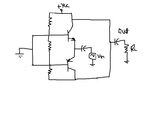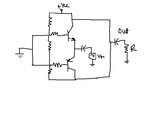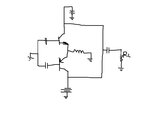goldsmith
Advanced Member level 6

- Joined
- Dec 14, 2010
- Messages
- 3,981
- Helped
- 741
- Reputation
- 1,486
- Reaction score
- 726
- Trophy points
- 1,413
- Location
- Tehran - IRAN
- Activity points
- 24,546
I can give you the answer , simply , but i think if you try to use your maximum power to think on it , this can help you in better way !
Prevent to connect bases together without any resistor ! you should use two resistors ! don't forget that this stage shouldn't give you high currents . this stage is just a voltage driver , and the main current amplification is up to , the next stage . so if the value of resistors be high there won't be any problem !
Prevent to connect bases together without any resistor ! you should use two resistors ! don't forget that this stage shouldn't give you high currents . this stage is just a voltage driver , and the main current amplification is up to , the next stage . so if the value of resistors be high there won't be any problem !






